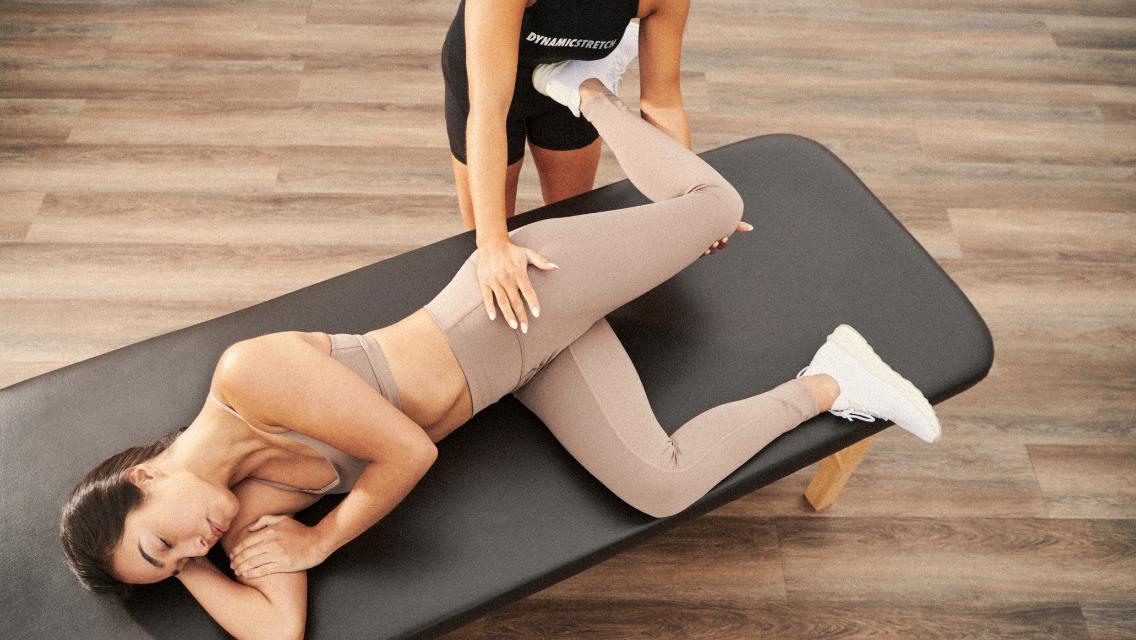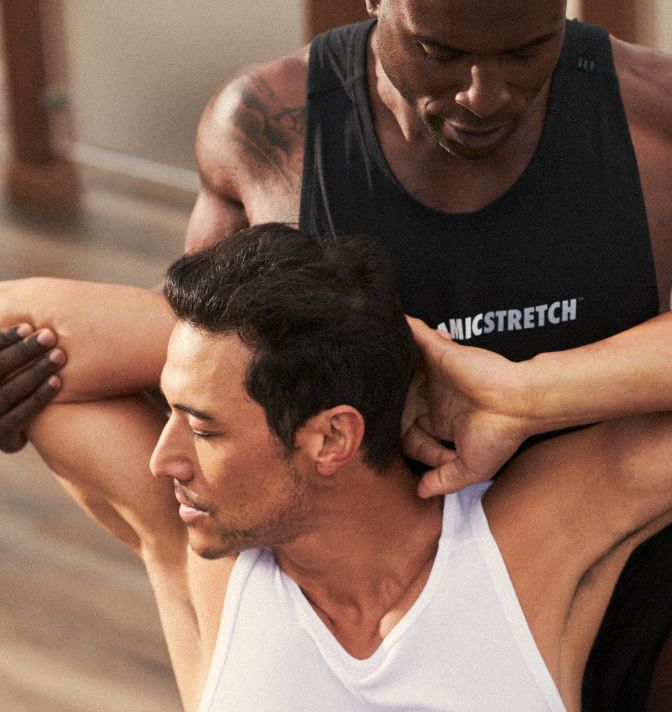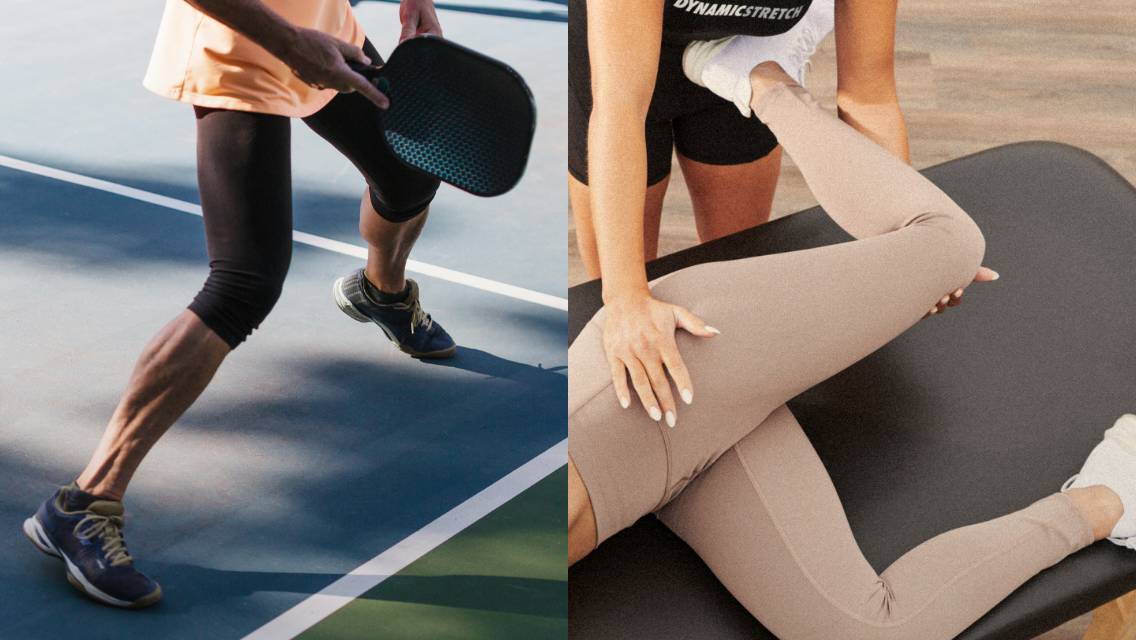Stretching is an essential component of any healthy-living routine, yet it’s often the activity that gets forgotten or deprioritized. For accountability, experts suggest turning to partner stretching (or assisted stretch) as a way to stay consistent with and reap all the advantages of a full-body stretch.
“There are so many benefits of assisted stretch,” says Joe Clark, dynamic personal training leader and stretch specialist at Life Time in Chestnut Hill, Mass. “Stretching with the help of a partner allows for increased range of motion as well as better positioning for your muscles to be lengthened with proper leverage. You also have another set of eyes on the quality and positioning of your body to assess your level of flexibility and continue to work toward improvement.”
We asked Clark to demonstrate three assisted stretches to help enhance your partner-stretching routine.
“All three of these stretches are based in proprioceptive neuromuscular facilitation (PNF) meaning we’re using a brief isometric muscle contraction to override the stretch reflex,” he explains. “This technique is one of the most effective ways to increase your range of motion and quickly and safely prepare your body for strength or endurance training. It’s one of my favorite stretch techniques to use with clients.”
1. Assisted Hip Flexor Stretch
“This stretch targets the hip flexors and psoas muscles,” says Clark. “It helps reduce low back pain, improve flexibility, and increase range of motion in the hip flexors, which can help with movement patterns, increased balance, and decreased muscle fatigue.”
- Partner 1 (the person stretching) starts by lying down in a supine position. You can use a stretching table or a bed or chaise at home.
- Partner 1 brings their hips to the very edge of the table or sofa and brings one leg up in a hip-flexion position (knee pulled toward chest) with the other leg hanging down off the edge.
- Partner 2 (the person assisting) presses down on the thigh of Partner 1’s hanging leg while also pressing the elevated leg straight back into flexion by leaning their chest or shoulder into Partner 1’s foot.
- Partner 1 lets Partner 2 know when they’re feeling a comfortable stretch (without pain) in the hip flexor and psoas (pelvis area).
- After 10 seconds of a passive stretch, Partner 1 takes a big breath in and contracts their hip flexors to press the thigh that’s on the table up into Partner 2’s hand for five seconds.
- After five seconds, Partner 1 exhales and relaxes.
- Repeat two to three times on each side, each time working toward a greater range of motion.
2. Assisted Chest Stretch
“For this stretch, we’re working on the chest muscles — pectoralis major and minor,” Clark explains. “This movement helps improve your posture, increase shoulder range of motion, and reduce risk of shoulder or chest injury, and can even help with better breathing.”
- Partner 1 (the person stretching) begins in a seated position, sitting tall on a stretching table, bed, or bench.
- Partner 2 (the person assisting) stands or kneels behind Partner 1 with their legs braced against Partner 2’s back.
- Partner 1 puts their hands behind their head while Partner 2 pulls back gently from the inside of Partner 1’s elbows while keeping contact and support on their back.
- Partner 1 lets Partner 2 know when they’re feeling a comfortable stretch (without pain) in their chest.
- After 10 seconds, Partner 1 takes a big breath in and resists Partner 2’s pulling by pushing their elbows into Partner 2’s hands for five seconds.
- Repeat two to three times, each time working toward a greater range of motion.
3. Assisted Hamstring Stretch
“The hamstrings are some of the largest muscles in your lower body, so it’s important to keep them stretched,” says Clark. “This particular move can help improve flexibility, relieve low-back pain, increase your ability to balance, and decrease muscle fatigue.”
- Partner 1 (the person stretching) begins in a supine position on a stretching table, bench, or floor, and raises one leg up straight up toward the ceiling (or as far as their knee extension allows without pain).
- Partner 2 (the person assisting) helps to stretch Partner 1’s raised leg by gently pressing into their calf; partner 2 can use their own leg to help keep partner 1’s other leg long on the table.
- Partner 1 lets Partner 2 know when they’re feeling a comfortable stretch (without pain) in the hamstring of the raised leg.
- After 10 seconds of a passive stretch, Partner 2 prompts partner 1 to take a big breath in and isometrically resist the stretch against Partner 2’s hand for 5 seconds.
- After about 5 seconds, Partner 1 exhales and relaxes.
- Repeat two to three times on each side, each time working toward further range of motion.
If you find you’re a fan of partner stretching and want more, Clark recommends trying a Dynamic Stretch session at Life Time.
“During a Dynamic Stretch session, our stretch specialists use the most advanced techniques to position your body in the most effective stretch possible,” he says. “We can also assess and identify imbalances and flexibility or mobility issues, and most importantly, build an on-going customized stretch program to keep you moving and feeling your best.”





